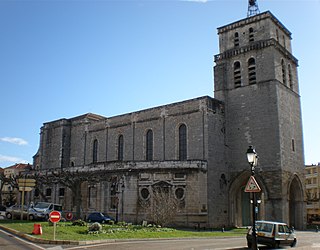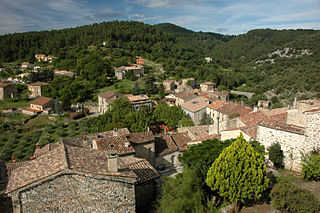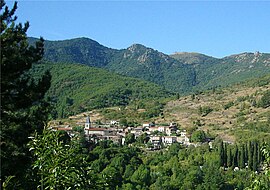
Ardèche is a department in Auvergne-Rhône-Alpes, Southeastern France. It is named after the river Ardèche and had a population of 328,278 as of 2019. Its prefecture is in Privas, but its largest city is Annonay.

The Cévennes is a cultural region and range of mountains in south-central France, on the south-east edge of the Massif Central. It covers parts of the départements of Ardèche, Gard, Hérault and Lozère. Rich in geographical, natural, and cultural significance, portions of the region are protected within the Cévennes National Park, the Cévennes Biosphere Reserve (UNESCO), as well as a UNESCO World Heritage Site: Causses and the Cévennes, Mediterranean agro-pastoral Cultural Landscape. The area has been inhabited since 400,000 BCE and has numerous megaliths which were erected beginning around 2500 BCE. As an agriculturally-rich area, but not a suitable location for cities, the Cévennes developed a wide diversity of pastoral systems, including transhumance. The irrigation and road networks put in place in the early Middle Ages for these pastoral systems are still in use today.

Alès is a commune and subprefecture in the Gard department in the Occitania region in Southern France. Until 1926, it was officially known as Alais. In 2019, it had a population of 41,837.

Uzès is a commune in the Gard department in the Occitanie region of Southern France. In 2017, it had a population of 8,454. Uzès lies about 25 kilometres north-northeast of Nîmes, 40 kilometres west of Avignon, and 32 kilometres south-east of Alès.

Castres is the sole subprefecture of the Tarn department in the Occitanie region in Southern France. It lies in the former province of Languedoc, although not in the former region of Languedoc-Roussillon. In 2018, the commune had a population of 41,795.

Le Vigan is a commune in the Gard department in southern France. It is a sub-prefecture of the department.

Roquemaure is a small town and commune in the Gard department of southern France. The town lies 12 kilometres north of Avignon on the right bank of the Rhône. In 2017 the commune had a population of 5,481.

Saint-Guilhem-le-Désert is a commune in the Hérault department in the Occitanie region in southern France. Situated where the Gellone river's narrow valley meets the steep-sided gorge of the river Hérault, Saint-Guilhem-le-Désert is essentially a medieval village located on the Chemin de St-Jacques pilgrim route to Santiago de Compostella.

The arrondissement of Le Vigan is an arrondissement of France in the Gard department in the Occitanie region. It has 74 communes. Its population is 39,243 (2016), and its area is 1,390.6 km2 (536.9 sq mi).

Sainte-Cécile-d'Andorge is a commune in the Gard department in southern France.

Sommières is a commune in the Gard department in southern France, located at the border with the Hérault department.

Saint-Martin-d'Ardèche is a commune in the department of Ardèche in Southern France.

The War of the Camisards or the Cévennes War was an uprising of Protestant peasants known as Camisards in the Cévennes and Languedoc during the reign of Louis XIV. The uprising was a response to the Edict of Fountainebleu in 1685.

Vauvert is a commune in the far south of the Gard department in southern France. It was known as Posquières in the Middle Ages. The commune comprises the town of Vauvert and the villages of Gallician and Montcalm. Over a third of the population work in industry, which is largely the food industry, especially wine production. The original settlement was called Posquières and was first mentioned in a document of 810. Since then the town has increased in importance and has had a rich history. At its heyday in the mid-nineteenth century it had a population of 6,000 but this decreased by a third after disease struck the grape crop, the mainstay of the economy of the area. Today, the population has grown again to over 11,000.

Aubais is a commune in the Gard department in southern France.

Anduze is a commune in the Gard department in southern France. The village is at the foot of the Cevennes range, in the limestone plateau of the Languedoc scrublands.

Calvisson is a commune in the Gard department in the Occitanie region in southern France.

Pouzilhac is a French commune in the Gard department in southern France, formerly Languedoc-Roussillon.

Banne is a commune in the Ardèche department in the Auvergne-Rhône-Alpes region of southern France.
The canton of Le Vigan is an administrative division of the Gard department, southern France. Its borders were modified at the French canton reorganisation which came into effect in March 2015. Its seat is in Le Vigan.























